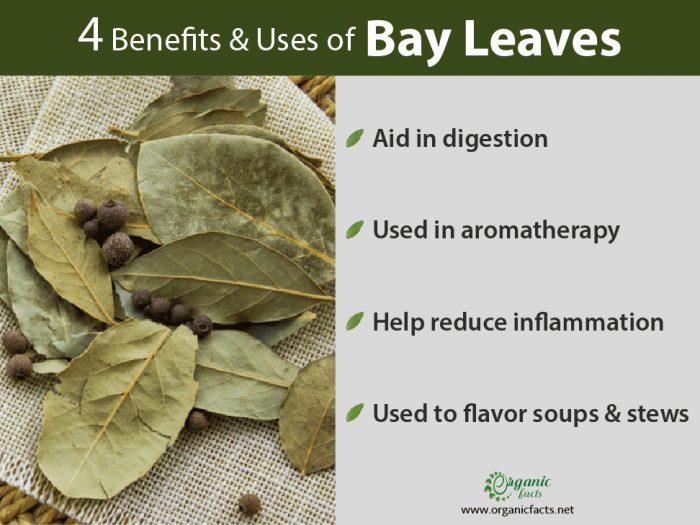Bay leaves are known for their potential ability to protect the body against oxidative stress and aid in the management of diabetes. They may also help in improving heart health, reducing inflammation, alleviating respiratory issues, and optimizing digestion.
What are Bay Leaves?
There are many types of plants containing leaves referred to as “bay leaves”, but the true bay leaf is scientifically known as Laurus nobilis. This is the nutrient-rich variety that is discussed in the article. Many other leaves have a similar appearance and aroma like true bay leaves, but not the same nutrient content. This plant is a small tree native to the Mediterranean region. Laurel trees were present everywhere in the region, but changing climates have diminished their presence. However, these leaves have been a part of the culinary and medicinal world for thousands of years, dating to at least the ancient Roman times.
How to Use Bay Leaves?
uses of bay leaves include grinding the leaves into a spice to flavor soups and stews, but they are most commonly added in their whole form as a flavoring for certain Italian dishes. They are removed from the dish prior to consuming or used as a garnish. Whole leaves are not commonly consumed. There is no extensive range of culinary applications for bay leaves, although extracts of these leaves have numerous medical uses. These leaves are also a popular element in aromatherapy and herbal treatments for various skin and respiratory conditions.
Health Benefits of Bay Leaves
With the wide range of benefits that these powerful leaves may offer, it is necessary to include them in your diet. Let us explore them in detail.
May Improve Digestion
Bay leaves have been used traditionally to relieve symptoms of indigestion and other stomach-related ailments. According to a 2019 report published in the Medicinal Plants of South Asia Journal, bay leaves not only add great flavor and taste to the food, but also help to give relief from abdominal pain, gastrointestinal infections, flatulence, bloating, constipation, and diarrhea. It is may also be used as a diuretic. However, more research is needed focusing on the effects of bay leaves to truly prove their efficacy on digestion. [3]
Can Help Relieve Respiratory Conditions
Bay leaves have strong antibacterial properties as per a research published in the Biological and Pharmaceutical Bulletin. When the essential oil of bay leaves is extracted, it can be mixed into a salve and applied to the chest to help alleviate various respiratory conditions. This can also be achieved with a poultice made of the leaves. Spread it on the chest and allow it to remain overnight. Inhaling the vapor has a similar effect to aromatherapy and can loosen up the phlegm and eliminate dangerous bacteria that may be trapped in your respiratory tracts, thanks to its natural antibacterial quality.
Note: However, it is highly recommended to consult a health specialist before trying this remedy at home.
May Improve Hair Health
Anecdotal evidence suggests that bay leaf can work wonders to treat dandruff and
Might Aid As An Anti-inflammatory Agent
One of the most important benefits of bay leaf is its ability to reduce inflammation throughout the body. This is confirmed by a study published in the Phytotherapy research journal.
Bay leaves contain a unique phytonutrient, called parthenolide, which can quickly reduce inflammation and irritation when topically applied to affected areas, such as sore joints or areas affected by arthritis. This effect can also be achieved through the normal consumption of bay leaf spice.
Can Be Used To Improve Or Protect Heart Health
Caffeic acid and rutin are both important organic compounds, found in bay leaves, that may help enhance our heart health. Rutin is said to strengthen capillary walls in the heart and the body’s extremities, while caffeic acid can help eliminate LDL or bad cholesterol from the cardiovascular system.

The uses of bay leaves include grinding the leaves into a spice to flavor soups and stews.
Can Help Reduce Anxiety & Stress
Linalool is often associated with thyme and basil, but it is also present in bay leaves. This compound can help lower the level of stress hormones in the body, especially when used in aromatherapy. Excess stress hormones can be dangerous for long-term health, so bay leaves might just have the ability to calm you down and help you remain relaxed even in your high-anxiety moments.
May Aid in Diabetes Management
Research suggests that bay leaves might have been connected with improved insulin receptor function and regulated blood sugar levels. For patients at risk of developing diabetes or for those who have already developed the condition, regular consumption of bay leaves may significantly lower the chances of diabetic episodes. While these findings are promising, more studies with larger sample sizes should be conducted to bolster the current research.
Word of Caution: As mentioned earlier, “bay leaf” is a commonly used term that applies to many different plants around the world; however, to achieve all of the health benefits listed above, it is essential that you find a true bay leaf, derived from the laurel tree. Other varieties can actually be toxic when consumed, so be certain that you’re getting the real thing. In terms of allergies, bay leaves aren’t widely known as an allergenic substance, but contact dermatitis and eczema breakouts have been sporadically reported. If you’re allergic to other members of the Lauraceae family, you will likely be allergic to bay leaves as well.































0 Comments